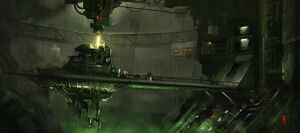Phlogiston: Difference between revisions
m (1 revision imported) |
|
(No difference)
| |
Latest revision as of 23:10, 20 March 2019
Phlogiston is a chymetic condensation which can occur in economically significant quantities at almost any location, ranging from deep space, planetary surfaces, or asteroids. Phlogiston is named for the classical element, which was theorised to be the medium by which combustion occurred. It usually takes the form of a thick, viscous fluid, glowing faintly--with the colour depending on a host of different factors, and has an exceptionally high energy density, making it very valuable. Phlogiston deposits usually form where high energy ley lines pass through pockets of gas or liquid.
Phlogiston has diverse industrial, civilian, and military applications, and is one of the most commonly extracted and utilised condensations. Its primary use is as a fuel source, both in coronatite furnaces and pure phlogiston reactors. However, give proper refinrement, phlogiston can also forms the basis of many other chymetic technologies. Purely on its own, phlogiston can be highly toxic to creatures in realspace, though some biothaumists believe that phlogiston is a 'food' source or storage for as yet unknown aetheric creatures.
Properties
Extraction and Refinement
Classifications
Applications
Power Generation
The most common use of phlogiston is power generation. Phlogiston can be converted into both heavy fuel phlog for use in coronatite expansion engines, or light kaurosen for use in reactors. Both of these technologies work via the 'ignition' of phlogiston, which causes the real world condensate to release the majority of its stored chymetic energy, while the original real world matter--along with traces of residual aetheric energy--is released as waste miasma. Miasma is usually considered to be a hazardous by product of phlogiston based power generation as it can, in large enough quantities, cause a spontaneous unplanned release of aetheric energy. As such, aboard most vessels using coronatite expansion engines, waste miasma is vented into the void. Reactor using craft can recycle the released miasma for a few more ignition cycles, but the resultant waste must be carefully purged from the reactor chamber on a fairly regular basis, as even the re-used waste miasma can prove to be dangerous.
Weaponry
Alongside power generation, phlogiston is commonly used in weaponry. The first form of phlogiston weaponry was the phloglock, which consisted solely of a phlogiston vial loaded into a weapon. The vial would then be broken and ignited, generating a beam of aetheric energy, commonly known as an aeth. However, pure aeths have a tendency to quickly dissipate into miasma, rendering a phloglock a short ranged weapon. Moreover, the reaction is relatively inefficient, as much of the phlogiston's intitial energy is locked into the waste miasma. However, the work of Lady Allysane Tenever resulted in the creation of the modern lasbolt, which serves as the primary form of weaponised phlogiston at present. Lasbolts are often also known as tenever bolts after their creator.
The base idea of a lasbolt weapon is the self contained cartridge, which consists of two distinct pieces: a phlogiston based exciter, converted into a stable powder form, and a coronatite focus shard. The phlogiston powder is contained within a rigid phlog-permeated cartridge that functions as the primer to ignite the exciter. Upon ignition, the powdered phlogiston converts back to its aetheric energy form, and is shaped by the barrel and coronatite focus into a concentrated. The focus allows a lasbolt cartridge to maintain its cohesion at much longer range than a pure phloglock design. More importantly, changing the shape and other characteristics of the flanelite focus allows the nature of the bolt to be controlled. Some focii designs create very narrow, highly focused beams for penetrating physical armour, while others allow for a looser focus that is more effective against reflectors. Still others allow for the lasbolt to ‘detonate’ after a certain period of time to create a kind of flak effect.
Lasbolt weapons are used extensively throughout the whole of the Imperial and Federal military, from the warships of the Navy to the rifles and Reinhold Guns of the Common Army. Notably, labsolts are particularly effective against reflectors, making them a popular weapon overall. However, especially with regards to void engagements, lasbolts are considered 'short ranged' when compared to other weapons, as even the focused beam still tends to dissipate rapidly, and the effect is magnified in atmosphere.

